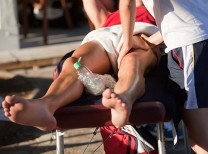Osteoarthritis is the most common form of arthritis and is a chronic disorder that gradually progresses over time. According to a study by the American College of Rheumatology, 70% of the population over the age of 70 show x-ray evidence of osteoarthritis. In the knee, the symptoms of osteoarthritis may include pain, stiffness, swelling, “locking,” and “catching”. These symptoms may progress to an eventual limitation of activities whether it is an inability to run, or an inability to walk up and down stairs.
The knee is one of the most common joints affected, particularly the articular cartilage. Articular cartilage is the smooth coating that covers the surface of the bones inside the knee. It also cushions and helps lubricate the joint surfaces. With osteoarthritis the articular cartilage begins to degrade and, over time, can thin or form cracks. Pieces of cartilage may come loose and float inside the knee, further irritating the joint. After a long period of time, this cartilage can become completely “worn away” and the bones then rub together.
Diagnosis
The clinical diagnosis of osteoarthritis typically relies on characteristic radiographic changes in the affected joint. The radiograph is the primary investigative resource in diagnosis and assessment of the severity of structural changes within the joint. In severe cases that may not be responding to treatment or depending on the extremity involved, Magnetic Resonance Imaging (MRI) technology may be used as it permits assessment of total cartilage content and integrity. MRI evaluates the cartilage as a positive image as opposed to radiographic techniques in which the cartilage is represented as the space between the opposing joint margins. Both technologies allow for the identification of specific landmarks, and repeat images can be aligned to allow a more precise determination of change.1
In much of the world, the WOMAC index (with its attendant subscales) is the predominant means of assessing changes in pain, stiffness, and function in patients with osteoarthritis. Additional instruments are also available and validated but are not as widely utilized.2
Treatment Options
Every osteoarthritic condition is different, and there should be a team approach to treatment. Some available treatments include exercise, medication, education on activity modification, weight loss, hot and cold therapy, techniques for joint protection, injections and (in some cases) surgery. Doctors and physical therapists who specialize in treating people with osteoarthritis will outline a treatment program. There is no cure for osteoarthritis, and the therapies currently available are used only to treat the symptoms. The 3 main goals of treatment for osteoarthritis are:
- Maintain or improve function (ability to climb stairs, play sports, etc.)
- Decrease pain
- Maintain or improve range of motion (ability to bend and straighten the joint)
Often, many different types of therapy are used together to improve symptoms. The severity of an individual’s condition, level of activity and expectations for function, determine which treatment is best.
Education and Biomechanical Treatment Options
- Educational Resources
- Lifestyle Modifications
- Physical Therapy
- Supportive Devices (Canes, Braces, Orthotics)
Is Regular Exercise Good or Bad for Osteoarthritis? Many people believe that exercise wears away the joint cartilage even more. Adults in the United States are already very sedentary. Over half don’t meet the minimum standard for physical activity. A diagnosis of osteoarthritis (OA) often pushes them toward greater inactivity. But the truth is that moderate exercise early on is one of the best ways to reduce hip or knee pain from OA. In fact, studies show that activity has the same effect on cartilage as it does on muscle and bone. It enhances and improves cartilage rather than wear it down. More research is needed to identify the optimum exercise program. For now, adults with an early diagnosis of OA are advised to stay active and exercise regularly.3
Surgical Treatment Options
- Arthroscopic Knee Surgery and Abrasion Arthroplasty
- Total Knee Replacement Surgery
- Partial Knee Replacement Surgery
- Articular Cartilage Transplantation and Cellular Implant Surgery
For very advanced cases of osteoarthritis, joint surgery may be recommended by your physician. According to the American Association of Orthopedic Surgeons, fewer than two percent of people undergoing knee replacement surgery experience serious complications. Following are some of the risks associated with Total Knee Replacement according to the Mayo Clinic.4
- Infection
- Knee stiffness
- Blood clots in leg veins or lungs
- Heart attack
- Stroke
- Nerve damage
Infection can be an ongoing concern even years after surgery as bacteria can travel through your bloodstream and infect the surgical site.
Medications and Nutritional Supplements
- Oral Medications (Pills)
- Topical Medications (Ointments and Creams)
- Injections
For mild arthritic conditions, medication alone may be a sufficient form of treatment. For more advanced cases, we have found success in programs that combine image-guided injections with tailored physical therapy programs and the temporary use of supportive devices. Integrative, non-surgical therapies such as these can prolong – and in some cases even eliminate – the need for Total Knee Replacement.
Dr. Gupta is Board Certified in both Anesthesiology and Pain Medicine. He is the Medical Director at The OsteoArthritis Center Rancho Mirage which specializes in the non-surgical treatment of Osteoarthritis, Degenerative Joint Disease and other musculoskeletal and chronic pain conditions. For more information contact Dr. Gupta and The OsteoArthritis Center at 760-321-1315.
References: 1) Guermazi A, Zaim S, Taouli B, Miaux Y, Peterfy CG, Genant HG. MR findings in knee osteoarthritis. Eur Radiol. 2003;13:1370-1386; 2) Bellamy N. WOMAC: a 20-year experiential review of a patient-centered self-reported health status questionnaire. J Rheumatol. 2002;29:2473-2476; 3) Moderate Exercise May Help Cartilage. Orthopedics Today. April 2006. Vol. 26. No. 4. Pp. 61.; 4) MayoClinic.com, May 15, 2010.









































Comments (0)